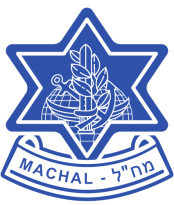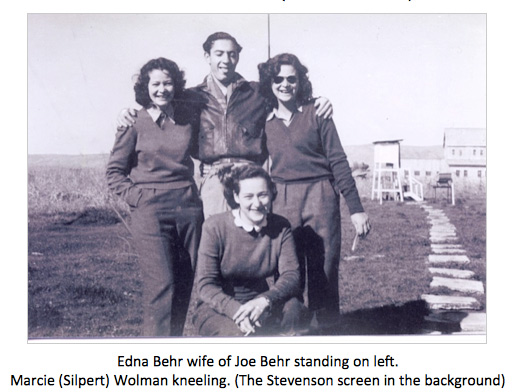
I was employed as an assistant shorthand typist at the Women’s and Men’s Division of the United Zionist Revisionist Party in Johannesburg when I joined Betar. Harry Hurwitz was the general secretary of the movement and Shulamith Becker was the secretary of Betar.
I became a passionate Zionist and a headstrong member of Betar. Besides working at the party offices during the day, most evenings were taken up with covert activities – meetings, preparing pamphlets which we mailed from the Jeppe Street Post Office in the dead of night, and weekend training. One weekend a bunch of us travelled on a tractor trailer to Kramer’s Farm in the Middleburg district and were instructed in the use of small arms, target shooting with a .22 rifle, Morse code and signals with flags. We marched in platoons – left, right, left… and Jeff Janks tried to teach me to drive. There was much cloak-and-dagger activity in the Jewish community and every week saw young Jewish men and women leaving from Palmietfontein Airport, the boys dressed mostly in brown corduroy pants and leather lumber-jackets.
I expected to travel to Israel with Shula and Grisha Golembo. Shula had asked me to accompany them to deliver some secret information to the Irgun in Europe. This information was sewn into one of Grisha’s shoes.
When the names of those who were chosen were announced, my name was not amongst them. Shula called in tears to tell me. I was devastated and I was advised to see Joe Lavine, who headed the selection committee. I begged and pleaded with him and eventually won the day.
In September 1948, on a Wednesday night, armed with passports, visas, and having subjected ourselves to yellow fever and malaria inoculations, we gathered at Palmietfontein Airport ready to leave. Emotional and tearful family members and friends were there to bid us farewell. After three abortive attempts to get going, we were finally airborne on the Sunday morning, four days later.
A group of 15 Betarim had gone ahead earlier, and our group of four girls – Shulamith Becker, Reeve Pitluk, Hettie Echilewitz, and myself – and 11 boys, following two or three weeks later. I wore a navy pinstripe suit and a hat with a feather on it!
Our journey to Rome was an adventure. We spent the first night in Kasama, then in Northern Rhodesia, made a short stop in Juba, and landed with engine trouble in Malakal, a godforsaken hole in the Sudan. We were stuck there for three scorching days and nights before being rescued by a Skymaster from Khartoum, where we spent a night being bitten by midges in intense heat at a hotel on the River Nile,
The Skymaster, heading for Rome, had a passenger for Cyprus. On taking off from Cyprus the undercarriage wouldn’t come up and we returned to Nicosia. With no available accommodation we were sent by bus to Kyrenia, a coastal town on the Mediterranean where we spent three blissful days relaxing in the sunshine. While we were enjoying the pleasures of tourists on one side of the island, deportees, detainees, and members of the Irgun, of which Betar was the youth movement, were incarcerated behind barbed wire in Famagusta, on the western side of the island.
We took off from Nicosia, stopped in Athens to drop off the fifteen members of the Athens Ballet Corps who had travelled with us from South Africa, and finally reached Rome.
We were at different hotels in Rome for the weekend, Shula and I at the Excelsior. We called at the Irgun headquarters, delivered Grisha’s shoes, and later on we were informed that the secret information was in shreds, so a good pair of shoes was ruined.
Our group met for dinner and I remember remarking that there was no plug for the bath and that we’d used our face cloths as makeshift ones. Someone informed us that you had to pay the hotel five shillings and you would be supplied with the requisite bathroom accessories.
From Rome we were sent north by train to Villa Forragiano on Lake Maggiore which was a Displaced Persons (DP) Camp run by the International Refugee Organization. Our fellow Betarim, who had preceded us, had done a yeoman’s job cleaning up the place. We were kept busy with work in the kitchen and “shmira” (guard duty). In the evenings we lined up on a makeshift parade ground and sang patriotic partisan songs.
The Villa is an historical building (built in 1841) with beautiful paintings on the ceilings and walls and lovely colorful tile work on the floors. The weather was beautiful and we took advantage of our time to browse the villages of Melna and Verona. We were introduced to delicious cassata ice cream and enjoyed excellent Italian spaghetti. We visited Isalobella, one of the islands on Lake Maggiore, and enjoyed the beauty of its gardens and statues.
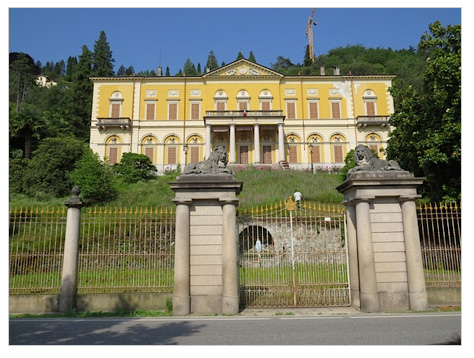
We were at Villa Forragiano for about two weeks, and the day before leaving we were given false names and histories to be used when questioned by officials of the International Refugee Organization – we wrote the information on the palms of our hands. One by one we were called into a room at the camp and interrogated in Italian, with a member of the camp as translator, Italian to Yiddish, of which I had a smattering, and Yiddish to Italian! The young Italian man seated at the desk opposite me was typing the information and embellishing it in English. My name was now Sala Redna, and I was born in Chrzanow, Poland, in October 1927. I was asked why I didn’t want to return to Chrzanow and while I knew the answer he was looking for was “communism,” I couldn’t remember the right answer, and I said that I had lost all my family and had nothing to return to. Grisha, when he was called in, had a complete blank and the interpreter made the excuse that he’s had typhus of the head and suffered memory lapses. Grisha thought he was off the hook, but the next day he was questioned. Reeve always wore a brooch with her name and she forgot to take it off.
Two days later we left by train for Naples where we found ourselves amongst hundreds of refugees waiting to board the “Tetti.” As I understood it, this was originally an American luxury cruiser built to accommodate 250 people but we were close to 800 passengers.
As Betarim and the least favored group, we were the last to board and were fortunate to be accommodated on the quoits deck with a tarpaulin over our heads and canvas stretchers to sleep on. There were park benches around the perimeter of the deck and lifeboats alongside. Some nights we slept five to two stretchers and took turns sleeping on the park benches. During the day we sunbathed in the lifeboats in shorts and shirts – often with our shirts off.
We were on the “Tetti” during Yom Kippur – 13th October 1948. Water and food were scarce and the sanitary conditions left much to be desired. The poor people in the cabins below deck were crowded and the stench was awful. Children relieved themselves on deck. We experienced one very bad night when we were hit by a gale. The sea was choppy, the boat was heaving, and the tarpaulin above our heads was filling with water. We were afraid we’d throw up if we got up to push the water out of the canvas.
The excitement when we finally sighted land was electric. We crowded the ship’s side and with the beautiful view of Haifa before us, we spontaneously burst into singing Hatikvah.
Shortly after leaving South Africa, Count Bernadotte, the UN Mediator, was assassinated in Jerusalem (17th September 1948), and when we arrived in Israel in the middle of October, the country was still on standby.
From Haifa we were taken to Tel Litwinsky for ten days of basic training. We were accommodated in tents and had our first taste of “chamsin” weather (hot winds from the desert). The heat was so intense that if you washed something and hung it on a guy rope it dried within 15 minutes.
I was sent to Air Force Headquarters in Jaffa to be trained as a weather observer in the meteorology section, where my cousin Myra Simon was an instructor.
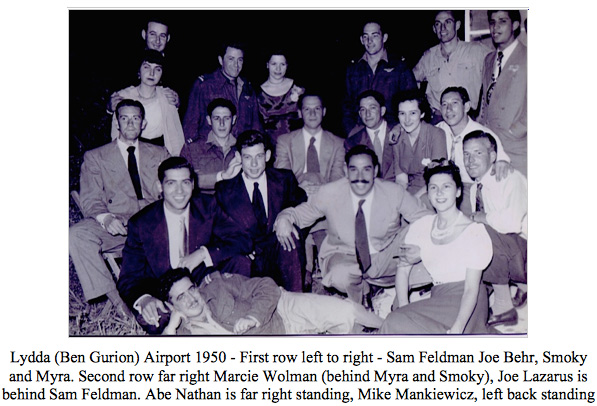
From Jaffa I was posted to Ramat David, the bomber base in the Emek. Danny Rosin was Commander of 103 Squadron and Sam Feldman of 69 Squadron. Bill Katz was the base commander.
Lily Sugarman was my roommate and good friend. She was in operations at the Ramat David airbase. She had recently returned from England in her quest for news of her husband Dov, who had been shot down on a mission and whose body had not been recovered.
I recall a night in April 1949 when one of the girls and I joined Sam Feldman on a training session in a B-17 plane doing “circuits and bumps.” On another evening I noticed a very sad looking Israeli girl in the dining hall and went over to talk to her. Friends of hers had been killed and she was mourning their loss. She invited me to go to Kastina with her to see her friend Ezer Weizman who was commander of the base, having taken over from Syd Cohen. Ezer took us for a wild ride in a jeep and I was happy to have survived!
In the met office where we worked shifts, there was a little paraffin stove and on our 12-hour night-shifts we were supplied with bread, jam, and tea. We’d heat water and toast the bread on the stove. Without realizing it I was steadily gaining weight! One day I found a few slabs of chocolate (strictly rationed and a luxury) on my desk together with an ad from the “Outspan,” a South African magazine, with advice on how to lose 50 lbs quickly! We were four English-speaking Machalnik girls on the base, so we were spoiled.
I was paid £3 a month which was raised to £5 when I was elevated to private first-class and given one stripe, and the South African office gave us ten shillings worth of stamps for sending letters home.
On 29th April 1949 (which happened to be my 21st birthday), the training base at Sde Dov was officially inaugurated. I was the only girl amongst the bunch of boys from Ramat David who were flying to the celebration. There was one passenger over the limit for the plane to carry, so our names were placed in a hat. I was excluded from the draw, and the unlucky one who was left behind was Abe Nathan, the Indian pilot. To this day I am sad because it was Abe’s birthday as well, and he should not have had to put his name in the hat
Dignitaries from Air Force Headquarters were at the Sde Dov celebrations including my cousins Myra and Smoky Simon. In the course of the evening someone told me to clench a fist, and then placed 21 matchsticks between my fingers and lit them. A chorus sang “Happy Birthday.”
Pesach (Passover) took place in the middle of April 1949 and members of the base were invited to seders in Haifa. Five of us were sent to a South African family, the Shapiros, where despite the severe rationing we enjoyed a traditional South African seder meal – chicken soup with matzah balls, following by a main course and dessert.
In the army truck taking us back to the base, Joe Lazarus continually bemoaned the fact that he had refused that third matzah ball. He had been sent to an Israeli family and had expected a main course to follow the soup, but the next course was dessert!
When dressing to go to the seder I was shocked to find that I couldn’t zip up the skirt of my navy pin stripe suit, and was lucky to find a dress Myra had given me that was of a stretchy fabric! With all the “daysa” (porridge) that was served at mealtimes, the boys lost weight and the girls gained.
On the occasion of the first Yom Ha’atzmaut (Independence Day), Golda Meir presented the women in the IDF (known as the “The Chen”) with a silver medallion on a chain.
In 1949 I was discharged from the Air Force and joined Moshav Habonim. Before settling on the Moshav I returned to South Africa briefly, and came back with a group in April 1950. Like every new member, I started off as a dishwasher in the kitchen, rising intermittently through the ranks to waitress, second cook, cook, and finally machsanit (running the storeroom). During this time there were breaks when I worked in the “lul” (chicken coops), the vermiculite factory, cleaned toilets, and was a new mother’s helper.
In 1951 I requested a leave of absence from the moshav and worked for the Citrus Marketing Board in Tel Aviv, before returning to South Africa for what was to be a month-long visit. After the hard work on the moshav, I felt I’d fallen into a feather bed and stayed for a year. At the end of 1952, as I was preparing to return to Israel, I met my future husband Nathan Wolman, and we were married seven weeks later. Natie was a farmer in the Delmas district and as fate would have it, I landed up on my own moshav.
I feel proud, grateful, and privileged, to have been in Israel at such an auspicious time in our history. A great disappointment is that my photograph and autograph albums were stolen from a parked car shortly after I returned to South Africa.
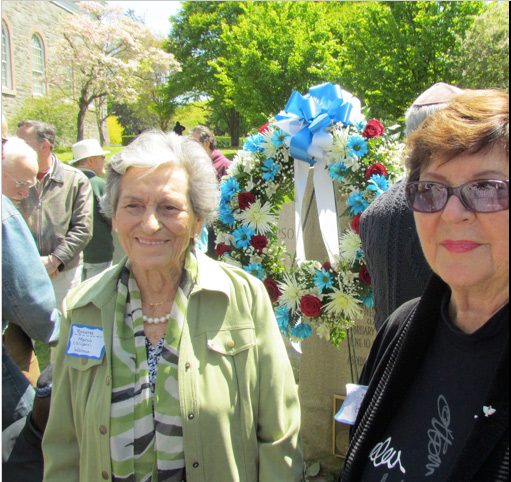
Over the years I have visited Israel many times, for Machal reunions – in 1968 after the Six-Day war, in 2002 and in 2008, and for family celebrations. I’ve been back to Ramat David and to Moshav Habonim.
At the time of the Machal reunion in 1968, Raphael Kotlowitz presented 11 of us South African Betarim with a medal from the Irgun.
Now, living in America, I’ve had the privilege of attending the Mickey Marcus Memorial Service at West Point Military Academy on two occasions. On the first occasion in 2002 I was honored to be asked to read the bios of four of the Americans who fell in the War of Independence, and was particularly moved when Dov Sugarman’s name was mentioned.
On 29th April 2012, which happened to be my birthday, the women of Machal were honored. My cousin Myra Simon came from Israel for the occasion and we enjoyed having children and grandchildren accompany us.
Over the years I often expressed the wish to visit Villa Forragiano and in 2013 after celebrating my 85th birthday my four children and I retraced the steps of my youth. The Villa is uninhabited and closed to the public but our wonderful guide managed to persuade the caretaker to open it up for us.
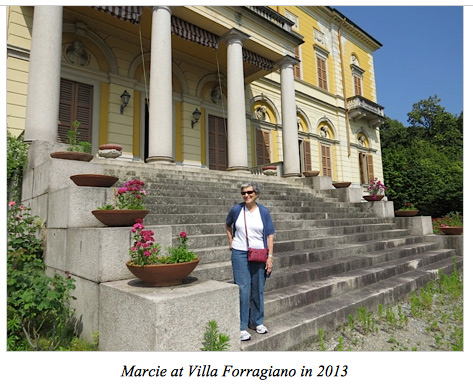
The paintings on the ceilings and walls were still there and except for the remodeled bathrooms, the place was much the same. I walked down to the basement where the laundry, shoemaker, and food stores were located and to the upper floors where, in years gone by, the servants were probably accommodated. I was able to point out the room in which I slept and the smelly toilet where, before entering, we pressed an eau-de-cologne soaked scarf to our noses.
During the war the Villa became a place of refuge for evacuees, soldiers and surviving Jews. In 1949 the descendants of the Foraggiano family donated the complex to the Nuns of the Order of the Poverello who first used it as an orphanage, and later as a convalescent home.
Before visiting the area, we took a ferry boat to Isalobella, where we strolled around the beautiful gardens and visited the Mansion and the Doll Museum. I remembered it as I had seen it in 1948.
Retracing the steps of my youth in the company of my four children was a gift.
Shula and I met in Israel many times over the years, but we never reminisced about our journey to Israel and the opportunity is now lost.
